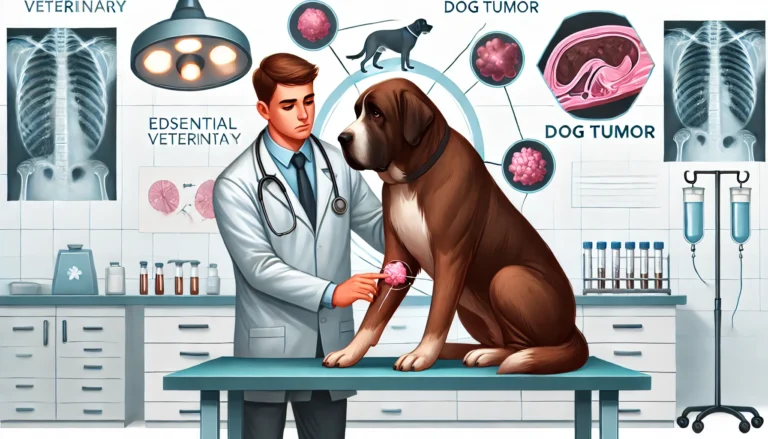Dog Throwing Up Blood? Causes, Treatment, and When to See a Vet

Seeing a dog throwing up blood can be alarming for any pet owner. This condition, called hematemesis, may occur due to various reasons, from minor stomach irritation to serious health problems like internal injuries or poisoning. Whether it’s specks of blood in your dog’s vomit or large amounts, it is crucial to understand what might be causing it.
This article will explore the potential causes of why my dog is throwing blood and help you identify when it’s time to act. Knowing the symptoms, treatments, and preventive steps can make all the difference in keeping your dog healthy.
What Does It Mean When a Dog Throws Up Blood?
When you see a dog throwing up blood, it means that there’s bleeding somewhere along the digestive tract or respiratory system. This condition, known as hematemesis, can vary from mild to severe. Sometimes, you might notice tiny specks of blood in your dog’s vomit, while in other cases, the vomit may contain larger clots or have a coffee-ground appearance.
The blood may be bright red (fresh bleeding) or look dark and grainy (partially digested blood), which gives clues about where the bleeding is coming from. For instance, fresh red blood could indicate an injury to the mouth or throat, while darker blood points to a problem deeper within the stomach or intestines.
Understanding what the blood looks like can help you communicate more clearly with your veterinarian and determine the severity of the issue.
Common Causes of Blood in Dog Vomit
A dog throwing up blood can result from several medical conditions. Some are minor, but others may require urgent care. Below are the most common causes of why your dog may be throwing blood:
1. Gastrointestinal Issues
- Stomach ulcers or severe gastritis can cause blood in your dog’s vomit.
- Irritation from stomach acid, infections, or medications like NSAIDs may damage the stomach lining.
2. Ingestion of Foreign Objects or Toxins
- Dogs sometimes swallow non-food items, like toys or bones, which can injure their digestive tract.
- Toxic substances (like rat poison or household cleaners) can cause internal bleeding, resulting in dog vomit with blood.
3. Injuries or Trauma
- Cuts or injuries in the mouth, throat, or esophagus can cause blood in a dog’s vomit. This often happens if the dog eats sharp objects.
- Severe coughing or vomiting can also rupture blood vessels, leading to dogs vomiting blood.
4. Blood-Clotting Disorders and Diseases
- Conditions such as liver disease or poisoning (e.g., ingesting anticoagulants) can affect a dog’s ability to clot blood. This could lead to blood spots in your dog’s vomit.
- Diseases like hemophilia or immune disorders may also cause dogs throwing up blood.
5. Infections and Parasites
- Parvovirus, hookworms, or bacterial infections can lead to vomiting with blood in your dog’s vomit.
- Puppies are more vulnerable to these infections, which can cause puppies throwing up blood.
6. Stress-Induced Gastritis
- Dogs under extreme stress (like after travel or loud events) may develop gastritis, which can cause bloody vomit. This condition occurs when the stomach lining becomes inflamed.

When to Worry: Signs That Require Immediate Veterinary Care
Not all cases of dog throwing up blood are emergencies, but some situations demand prompt veterinary attention. Knowing when to seek help can save your dog’s life. Below are critical warning signs to watch for:
1. Repeated Vomiting Episodes
- If your dog vomits blood more than once or continues throwing up over several hours, it could indicate a serious issue like internal bleeding or poisoning.
2. Lethargy and Weakness
- If your dog throwing up blood also appears weak, disoriented, or unable to stand, this may signal significant blood loss or an underlying disease.
3. Dog Throwing Up Blood and Not Eating or Drinking
- A dog refusing food or water, especially after vomiting blood, could be experiencing digestive distress or dehydration. Immediate vet care is necessary.
4. Foamy or Mucus-Like Vomit with Blood
- If your dog vomits white foam with blood or mucus mixed with red specks, it could point to gastrointestinal inflammation or respiratory problems.
5. Blood Mixed with Bile or Large Clots
- Dog vomiting bile and blood or large clots suggests more advanced gastrointestinal issues, such as ulcers or liver disease.
6. Unusual Behavior or Symptoms
- Be concerned if your dog throws up blood and shows other symptoms like:
- Difficulty breathing or excessive coughing
- Pale gums or signs of shock
- Diarrhea, especially with blood
In these situations, dogs vomiting blood need urgent veterinary care. Delaying treatment can lead to complications, making recovery more difficult.
Interesting Fact
Can dogs eat shrimp? Yes, shrimp can be safe for dogs to eat, but it depends on how it’s prepared and served. When cooked properly, shrimp offers several nutrients that can benefit dogs.
First Aid Steps and What You Can Do at Home
If you see your dog throwing up blood, it’s important to stay calm. While waiting for veterinary care, here are a few steps you can take to help your pet:
1. Keep Your Dog Calm and Resting
- Stress can worsen the situation. Make sure your dog stays in a quiet and comfortable space to reduce anxiety.
2. Withhold Food and Water Temporarily
- Don’t offer food or water immediately after vomiting. Wait a few hours to prevent further irritation to the stomach.
3. Check for Foreign Objects or Toxin Exposure
- Inspect your dog’s surroundings for anything unusual—like chewed-up toys, household cleaners, or plants. Knowing what your dog might have ingested can help the vet diagnose the problem.
4. Monitor for Additional Symptoms
- Take note of how often your dog throws up blood and if there are any other signs, like diarrhea or difficulty breathing.
5. Document Vomiting Episodes
- Keep a record of the frequency, amount, and appearance of the vomit (e.g., blood clots, bile, or foamy blood). This information will be useful for your veterinarian.
6. Avoid Medications Without Vet Approval
- Do not give your dog human medications or over-the-counter drugs without consulting a vet. Some medications can worsen the situation.
These steps are not a substitute for professional care. If the bleeding persists or other symptoms appear, take your dog vomiting blood to a vet immediately.
How Veterinarians Diagnose and Treat Vomiting Blood in Dogs
When you take your dog throwing up blood to the veterinarian, they will perform several diagnostic tests to determine the cause and provide the right treatment. Here’s what you can expect during the vet visit:
1. Physical Examination and Health History
- The vet will check your dog’s mouth, throat, and abdomen for signs of injury or infection.
- They’ll also ask questions about your dog’s symptoms, diet, possible toxin exposure, and any recent incidents involving foreign objects.
2. Diagnostic Tests
- Blood Tests: To check for infections, liver disease, or clotting disorders.
- X-rays or Ultrasound: These images help identify foreign objects, tumors, or abnormalities in the digestive tract.
- Endoscopy: A tiny camera inserted into the digestive tract can detect ulcers or blockages causing blood in dog vomit.
- Fecal Test: If parasites or infections are suspected, a stool sample may be analyzed.
3. Treatment Options
- IV Fluids: If your dog is dehydrated, the vet will administer fluids to restore hydration and balance electrolytes.
- Medications: Depending on the diagnosis, your dog may receive anti-nausea medications, antibiotics, or drugs to reduce stomach acid.
- Surgery: If the vet finds a foreign object or blockage, surgery may be necessary to remove it.
- Blood Transfusions: In severe cases of blood loss, a transfusion may be required.
4. Monitoring and Follow-Up Care
- After treatment, the vet may recommend follow-up visits to monitor recovery.
- Diet changes or additional medications may be prescribed to prevent future episodes of dogs vomiting blood.
The sooner you act, the better the outcome. Early diagnosis and treatment improve the chances of recovery, especially if the cause is serious, such as poisoning or gastrointestinal disease.
Preventing Blood Vomit in Dogs
Preventing dogs from throwing up blood involves proactive care and avoiding common risks. Below are a few strategies to reduce the chances of your dog experiencing blood in vomit:
1. Keep Harmful Substances Out of Reach
- Store household cleaners, medications, and toxic foods (like chocolate or grapes) in secure areas.
- Ensure your dog doesn’t have access to poisonous plants or rat bait, which can cause blood in dog vomit.
2. Supervise Play and Chewing Habits
- Monitor your dog when playing with toys to prevent ingestion of foreign objects.
- Avoid giving bones or sharp treats that could injure the digestive tract and lead to bloody vomit.
3. Provide a Balanced Diet and Hydration
- A nutritious diet helps prevent gastrointestinal problems and ulcers that may cause blood spots in dog vomit.
- Ensure your dog stays well-hydrated, especially during hot weather or strenuous activities.
4. Minimize Stress
- Dogs under stress can develop gastritis, leading to dogs vomiting blood. Create a calm environment and avoid sudden changes in routine to reduce anxiety.
5. Regular Veterinary Checkups
- Regular vet visits can detect underlying conditions like liver disease or parasites before they cause serious symptoms.
- Ensure your dog receives all necessary vaccinations, especially for diseases like parvovirus, which can cause puppies to vomit blood.
6. Monitor for Early Warning Signs
- Pay attention to your dog’s behavior and any unusual symptoms, such as mild vomiting or coughing. Addressing minor issues early can prevent them from escalating.
By following these preventive steps, you can reduce the risk of your dog vomiting blood and help ensure their long-term health and well-being.
Conclusion
Seeing your dog throwing up blood can be frightening, but understanding the possible causes and knowing when to act is crucial. While some cases may be minor, like specks of blood in dog vomit from a minor injury, others can indicate severe conditions such as poisoning, infections, or internal bleeding.
If you’re ever unsure why your dog is throwing blood, it’s best to consult a veterinarian quickly. Early diagnosis and treatment improve the chances of recovery, especially when dealing with serious health problems. Preventive care, a balanced diet, and regular vet visits can help keep your dog healthy and reduce the risk of future vomiting episodes.
Your pet’s well-being depends on swift action and attentive care. If your dog exhibits warning signs like repeated vomiting, lethargy, or not eating, don’t hesitate to seek professional help.
Frequently Asked Questions (FAQs)
1. Why is my dog vomiting blood but acting normal?
If your dog is throwing up blood but seems otherwise normal, it could be a minor issue like a small injury in the mouth or esophagus. However, it’s still important to monitor for any worsening symptoms or repeated vomiting.
2. Can stress cause a dog to vomit blood?
Yes, severe stress can lead to gastritis, which may cause dogs vomiting blood. Stress affects the digestive system, leading to stomach inflammation and bleeding in some cases.
3. What do I do if my puppy throws up blood?
Puppies are more vulnerable to infections like parvovirus, which can cause bloody vomit. If your puppy is throwing up blood, seek veterinary care immediately to prevent complications.
4. What does it mean if there are tiny specks of blood in my dog’s vomit?
Specks of blood in dog vomit could result from mild throat irritation, excessive coughing, or minor stomach irritation. However, if it continues or other symptoms appear, a vet check is recommended.
5. Can vomiting blood in dogs go away on its own?
In some cases, minor causes of dogs throwing up blood may resolve without intervention. However, it’s important to monitor your dog closely, as persistent or large amounts of blood indicate a need for medical care.
6. What causes a dog to vomit blood and foam?
Foamy blood in vomit may indicate gastrointestinal inflammation or respiratory issues. It’s best to consult a vet, especially if the vomiting continues or the dog shows signs of distress.






